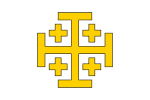Crusades
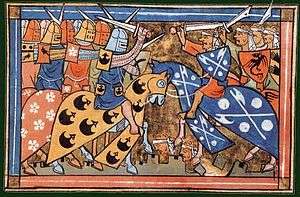
| Part of a series on |
| Christianity |
|---|
 |
|
|
|
The Crusades were a series of religious wars sanctioned by the Latin Church in the medieval period. The most commonly known Crusades are the campaigns in the Eastern Mediterranean aimed at recovering the Holy Land from Muslim rule, but the term "Crusades" is also applied to other church-sanctioned campaigns. These were fought for a variety of reasons including the suppression of paganism and heresy, the resolution of conflict among rival Roman Catholic groups, or for political and territorial advantage. At the time of the early Crusades the word did not exist, only becoming the leading descriptive term around 1760.
In 1095, Pope Urban II called for the First Crusade in a sermon at the Council of Clermont. He encouraged military support for the Byzantine Empire and its Emperor, Alexios I, who needed reinforcements for his conflict with westward migrating Turks colonizing Anatolia. One of Urban's aims was to guarantee pilgrims access to the Eastern Mediterranean holy sites that were under Muslim control but scholars disagree as to whether this was the primary motive for Urban or those who heeded his call. Urban's strategy may have been to unite the Eastern and Western branches of Christendom, which had been divided since the East–West Schism of 1054 and to establish himself as head of the unified Church. The initial success of the Crusade established the first four Crusader states in the Eastern Mediterranean: the County of Edessa, the Principality of Antioch, the Kingdom of Jerusalem and the County of Tripoli. The enthusiastic response to Urban's preaching from all classes in Western Europe established a precedent for other Crusades. Volunteers became Crusaders by taking a public vow and receiving plenary indulgences from the Church. Some were hoping for a mass ascension into heaven at Jerusalem or God's forgiveness for all their sins. Others participated to satisfy feudal obligations, obtain glory and honour or to seek economic and political gain.
The two-century attempt to recover the Holy Land ended in failure. Following the First Crusade there were six major Crusades and numerous less significant ones. After the last Catholic outposts fell in 1291 there were no more Crusades but the gains were longer lasting in Northern and Western Europe. The Wendish Crusade and those of the Archbishop of Bremen brought all the North-East Baltic and the tribes of Mecklenburg and Lusatia under Catholic control in the late 12th-century. In the early 13th century the Teutonic Order created a Crusader state in Prussia and the French monarchy used the Albigensian Crusade to extend the kingdom to the Mediterranean Sea. The rise of the Ottoman Empire in the late 14th-century prompted a Catholic response which led to further defeats at Nicopolis in 1396 and Varna in 1444. Catholic Europe was in chaos and the final pivot of Christian–Islamic relations was marked by two seismic events: the fall of Constantinople to the Ottomans in 1453 and a final conclusive victory for the Spanish over the Moors with the conquest of Granada in 1492. The idea of Crusading continued, not least in the form of the Knights Hospitaller, until the end of the 18th-century but the focus of Western European interest moved to the New World.
Modern historians hold widely varying opinions of the Crusaders. To some, their conduct was incongruous with the stated aims and implied moral authority of the papacy, as evidenced by the fact that on occasion the Pope excommunicated Crusaders. Crusaders often pillaged as they travelled, and their leaders generally retained control of captured territory instead of returning it to the Byzantines. During the People's Crusade, thousands of Jews were murdered in what is now called the Rhineland massacres. Constantinople was sacked during the Fourth Crusade. However, the Crusades had a profound impact on Western civilisation: Italian city-states gained considerable concessions in return for assisting the Crusaders and established colonies which allowed trade with the eastern markets even in the Ottoman period, allowing Genoa and Venice to flourish; they consolidated the collective identity of the Latin Church under papal leadership; and they constituted a wellspring for accounts of heroism, chivalry, and piety that galvanised medieval romance, philosophy, and literature. The Crusades also reinforced a connection between Western Christendom, feudalism, and militarism.
Terminology
The term crusade used in modern historiography at first referred to the wars in the Holy Land beginning in 1095, but the range of events to which the term has been applied has been greatly extended, so that its use can create a misleading impression of coherence, particularly regarding the early Crusades. The term used for the campaign of the First Crusade was iter "journey" or peregrinatio "pilgrimage".[1] The terminology of crusading remained largely indistinguishable from that of pilgrimage during the 12th century, reflecting the reality of the first century of crusading where not all armed pilgrims fought, and not all who fought had taken the cross. It was not until the late 12th to early 13th centuries that a more specific "language of crusading" emerged.[2] Pope Innocent III used the term negotium crucis "affair of the cross" for the Eastern Mediterranean crusade, but was reluctant to apply crusading terminology to the Albigensian crusade. The Song of the Albigensian Crusade from about 1213 contains the first recorded vernacular use of the Occitan crozada. This term was later adopted into French as croisade and in English as crusade.[3] The modern spelling crusade dates to c. 1760.[4] Sinibaldo Fieschi (the future pope Innocent IV) used the terms crux transmarina for crusades in Outremer against Muslims and crux cismarina for crusades in Europe against other enemies of the church.[5]
The Crusades in the Holy Land are traditionally counted as nine distinct campaigns, numbered from the First Crusade of 1095–99 to the Ninth Crusade of 1271–72. This convention is used by Charles Mills in his History of the Crusades for the Recovery and Possession of the Holy Land (1820) and is often retained for convenience even though it is somewhat arbitrary. The Fifth and Sixth Crusades led by Frederick II may be considered a single campaign, as can the Eighth Crusade and Ninth Crusade led by Louis IX.[6]
In modern historiography, the term "Crusade" may differ in usage depending on the author. Giles Constable describes four different perspectives among scholars:[7]
- Traditionalists restrict their definition of the Crusades to the Christian campaigns in the Holy Land, "either to assist the Christians there or to liberate Jerusalem and the Holy Sepulcher", during 1095–1291.[8]
- Pluralists use the term Crusade of any campaign explicitly sanctioned by the reigning Pope.[9] This reflects the view of the Roman Catholic Church (including medieval contemporaries such as Saint Bernard of Clairvaux) that every military campaign given Papal sanction is equally valid as a Crusade, regardless of its cause, justification, or geographic location. This broad definition includes attacks on paganism and heresy such as the Albigensian Crusade, the Northern Crusades, and the Hussite Wars, and wars for political or territorial advantage such as the Aragonese Crusade in Sicily, a Crusade declared by Pope Innocent III against Markward of Anweiler in 1202,[10] one against the Stedingers, several (declared by different popes) against Emperor Frederick II and his sons,[11] two Crusades against opponents of King Henry III of England,[12] and the Christian re-conquest of Iberia.[13]
- Generalists see Crusades as any and all holy wars connected with the Latin Church and fought in defence of the faith.
- Popularists limit the Crusades to only those that were characterised by popular groundswells of religious fervour – that is, only the First Crusade and perhaps the People's Crusade.[7]
The Arabic loanword Muslim is first attested in English in the 17th century. Before this the common term for Muslim was Saracen,[14] in origin referring to the pre-Islamic, non-Arab inhabitants of the desert areas around the Roman province of Arabia.[15] The term evolved to include Arab tribes, and by the 12th century it was an ethnic and religious marker in Medieval Latin literature corresponding to modern "Muslim".[16]
Frank and Latin were used during the Crusades for Western Europeans, distinguishing them from Greeks.[17][18] Medieval Muslim historiographers such as Ali ibn al-Athir refer to the Crusades as the "Frankish Wars" (ḥurūb al-faranǧa حروب الفرنجة).
The term used in modern Arabic, ḥamalāt ṣalībiyya حملات صليبية, lit. "campaigns of the cross", is a loan translation of the term Crusade as used in Western historiography.[19]
Eastern Mediterranean
Background
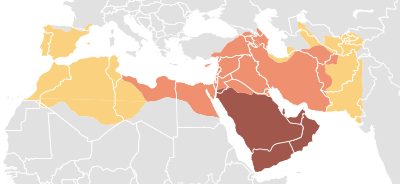
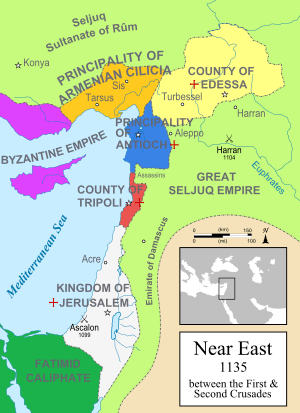
The Islamic prophet Muhammad founded Islam in the Arabian Peninsula and had united much of Arabia into a single polity by his death in 632. Arab power expanded rapidly in the 7th and 8th centuries largely by military conquest. This influence spread to the northwest Indian subcontinent, across Central Asia, the Middle East, North Africa, southern Italy, the Iberian peninsula and the Pyrenees. Jerusalem was taken from the Byzantine Empire after a siege in 637.[20][21][22]
Tolerance, trade, and political relationships between the Arabs and the Christian kingdoms waxed and waned. Pilgrimages by Catholics to sacred sites were permitted, Christian residents in Muslim territories were given Dhimmi status, legal rights, and legal protection. These Christians were allowed to maintain churches, and marriages between faiths were not uncommon.[23] The various cultures and creeds coexisted and competed, but the status quo was disrupted by the western migration of the Turkish tribes. The 1071 victory over the Byzantine army at the Battle of Manzikert was once considered a pivotal event by historians but is now regarded as only one further step in the expansion of the Great Seljuk Empire into Anatolia.[24] Catholic pilgrims and merchants reported that the frontier conditions between the Syrian ports and Jerusalem became increasingly inhospitable.[25]
From the 8th century, the Christians entered to recapture the Iberian peninsula from the Muslims, known as the Reconquista. The campaign reached a turning point in 1085 when Alfonso VI of León and Castile captured Toledo.[26] In the same period, the Muslim Emirate of Sicily was conquered by Norman adventurer Roger de Hauteville in 1091.[27]
Europe was immersed in power struggles on many different fronts. The Christian Church split along Latin Orthodox lines in 1054 after centuries of disagreement leading to a permanent division called the East–West Schism.[28] Following the Gregorian Reform, an assertive, reformist papacy attempted to increase its power and influence over the laity. Beginning around 1075 and continuing during the First Crusade, the Investiture Controversy was a power struggle between Church and state in medieval Europe over whether the Catholic Church or the Holy Roman Empire held the right to appoint church officials and other clerics.[29][30] Antipope Clement III was an alternative pope for most of this period, and Pope Urban spent much of his early pontificate in exile from Rome. The result was intense piety and an increased interest in religious affairs amongst the general population in Catholic Europe and religious propaganda by the Papacy advocating a just war to reclaim Palestine from the Muslims. Participation in a crusade was seen as a form of penance that could counterbalance sin.[31]
First Crusade (1096–1099) and aftermath
In 1095, at the Council of Piacenza, Byzantine Emperor Alexios I Komnenos requested military aid from Pope Urban II, probably in the form of a small body of mercenary reinforcements he could direct and control. Alexios had restored the Empire's finances and authority, but he still faced a number of foreign enemies, particularly the migrating Turks who had colonised the sparsely populated areas of Anatolia.[32] At the Council of Clermont later that year, Urban raised the issue again and preached for a Crusade. Many historians consider that Urban also hoped that aiding the Eastern Church would lead to its reunion with the Western under his leadership.[33]
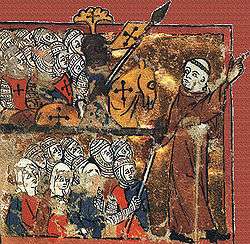
Almost immediately Peter the Hermit led thousands of mostly poor Christians out of Europe in what became known as the People's Crusade.[34] He claimed he had a letter from heaven instructing Christians to prepare for the imminent apocalypse by seizing Jerusalem [35] The motivations of this Crusade included a "messianism of the poor" inspired by an expected mass ascension into heaven at Jerusalem.[36] Germany witnessed the first incidents of major violent European antisemitism when these Crusaders massacred Jewish communities in what become known as the Rhineland massacres.[37] In Speyer, Worms, Mainz, and Cologne the range of anti-Jewish activity was broad, extending from limited, spontaneous violence to full-scale military attacks.[38] The Crusaders journeyed, despite advice from Alexios' to wait for the nobles, to Nicaea. Only 3000 survived an ambush by the Turks at the Civetot.[39]
Both Philip I of France and Emperor Henry IV were in conflict with Urban and declined to participate in the official crusade. However, members of the high aristocracy from France, western Germany, the Low countries, and Italy were drawn to the venture, commanding their own military contingents in loose, fluid arrangements based on bonds of lordship, family, ethnicity, and language. Foremost amongst these was the elder statesman, Raymond IV, Count of Toulouse. He was rivalled by the relatively poor but martial Bohemond of Taranto and his nephew Tancred from the Norman community of southern Italy. They were joined by Godfrey of Bouillon and his brother Baldwin I of Jerusalem in leading a loose conglomerate from Lorraine, Lotharingia, and Germany. These five princes were pivotal to the campaign that was also joined by a Northern French army led by Robert Curthose, Stephen, Count of Blois, and Robert II, Count of Flanders.[40] The armies, which may have contained as many as 100,000 people, including non-combatants, travelled eastward by land to Byzantium where they were cautiously welcomed by the Emperor.[41] Alexios persuaded many of the princes to pledge allegiance to him and that their first objective should be Nicaea, which Kilij Arslan I had declared the capital of the Sultanate of Rum. Having already destroyed the earlier People's Crusade, the over-confident Sultan left the city to resolve a territorial dispute, enabling its capture in 1097 after a Crusader siege and a Byzantine naval assault. This marked a high point in Latin and Greek co-operation and also the start of Crusader attempts to take advantage of political and religious disunity in the Muslim world: Crusader envoys were sent to Egypt seeking an alliance.[42]
The Crusades' first experience with the Turkish tactic of lightly armoured mounted archers occurred when an advanced party led by Bohemond and Duke Robert was ambushed at Dorylaeum. The Normans resisted for hours before the arrival of the main army caused a Turkish withdrawal. After this, the nomadic Seljuks avoided the Crusade.[43] The factionalism amongst the Turks that followed the death of Malik Shah meant they did not present a united opposition. Instead, Aleppo and Damascus had competing rulers.[44] The three-month march to Antioch was arduous, with numbers reduced by starvation, thirst, and disease, combined with the decision of Baldwin to leave with 100 knights in order to carve out his own territory in Edessa.[45] The Crusaders embarked on an eight-month siege of Antioch but lacked the resources to fully invest the city; similarly, the residents lacked the resources to repel the invaders. Eventually, Bohemond persuaded a tower guard in the city to open a gate and the Crusaders entered, massacring the Muslim and many Christian Greeks, Syrian and Armenian inhabitants.[46]
Sunni Islam now recognised the threat. The sultan of Baghdad raised a force to recapture the city led by the Iraqi general Kerbogha. The Byzantines provided no assistance to the Crusaders' defence of the city because the deserting Stephen of Blois told them the cause was lost. Losing numbers through desertion and starvation in the besieged city, the Crusaders attempted to negotiate surrender, but this was rejected by Kerbogha, who wanted to destroy them permanently. Morale within the city was boosted when Peter Bartholomew claimed to have discovered the Holy Lance. Bohemond recognised that the only option now was for open combat, and he launched a counterattack against the besiegers. Despite superior numbers, Kerbogha's army, which was divided into factions and surprised by the commitment and dedication of the Franks, retreated and abandoned the siege.[47] The Crusaders then delayed for months while they argued over who would have the captured territory. This ended only when news arrived that the Fatimid Egyptians had taken Jerusalem from the Turks, and it became imperative to attack before the Egyptians could consolidate their position. Bohemond remained in Antioch, retaining the city despite his pledge that this would return to Byzantine control, while Raymond led the remaining Crusader army rapidly south along the coast to Jerusalem.[48]
An initial attack on the city failed and, due to the Crusaders' lack of resources, the siege became a stalemate. However, the arrival of craftsman and supplies transported by the Genoese to Jaffa tilted the balance in their favour. Crusaders constructed two large siege engines; the one commanded by Godfrey breached the walls on 15 July 1099. For two days the Crusaders massacred the inhabitants and pillaged the city. Historians now believe the accounts of the numbers killed have been exaggerated, but this narrative of massacre did much to cement the Crusaders' reputation for barbarism.[49] Godfrey further secured the Frankish position by surprising the Egyptian relief force commanded by the vizier of the Fatimid Caliph, Al-Afdal Shahanshah, at Ascalon. This relief force retreated to Egypt, with the vizier fleeing by ship.[50] At this point most of the Crusaders considered their pilgrimage complete and returned to Europe, leaving behind Godfrey with a mere 300 knights and 2,000 infantry to defend Palestine. Of the other princes, only Tancred remained with the ambition to gain his own princedom.[51]
On a popular level, the First Crusade unleashed a wave of impassioned, pious Catholic fury – expressed in the massacres of Jews that accompanied the Crusades[52] and the violent treatment of the "schismatic" Orthodox Christians of the east which occurred at Antioch.[53] The Islamic world seems to have barely registered the Crusade; certainly there is limited written evidence before 1130. This may be in part due to a reluctance to relate Muslim failure, but it is more likely to be the result of cultural misunderstanding. Al-Afdal and the Muslim world mistook the Crusaders for the latest in a long line of Byzantine mercenaries rather than religiously motivated warriors intent on conquest and settlement.[54] In any case, the Muslim world was divided between the Sunnis of Syria and Iraq and the Shia Fatimids of Egypt. Even the Turks were divided, with rival rulers in Damascus and Aleppo. In Baghdad the Seljuk sultan vied with an Abbasid caliph in a Mesopotamian struggle. This gave the Franks a crucial opportunity to consolidate without any pan-Islamic counterattack.[55]
12th century
Under the papacies of successive Popes smaller groups of Crusaders continued to travel to the Eastern Mediterranean to fight the Muslims and aid the Crusader States in the early 12th century. The third decade saw campaigns by Fulk V of Anjou, the Venetians, and Conrad III of Germany and the foundation of the Knights Templar.[56] The period also saw the innovation of granting indulgences to those who opposed papal enemies, and this marked the beginning of politically motivated Crusades.[57] The loss of Aleppo in 1128 and Edessa (Urfa) in 1144 to Imad ad-Din Zengi, governor of Mosul, led to preaching for what subsequently became known as the Second Crusade.[58][59][60] King Louis VII and Conrad III led armies from France and Germany to Jerusalem and Damascus without winning any major victories.[61] As in the First Crusade, the preaching led to attacks on Jews including massacres in the Rhineland, Cologne, Mainz, Worms and Speyer amid claims that the Jews were not contributing financially to the rescue of the Holy Land. Bernard of Clairvaux, who had encouraged the Second Crusade in his preaching, was so perturbed by the violence that he journeyed from Flanders to Germany to deal with the problem.[62][63]
Christian princes continued to make gains in the Iberian peninsula: the King of Portugal, Afonso I, captured Lisbon and Raymond Berenguer IV of Barcelona conquered the city of Tortosa.[64][65] In northern Europe the Saxons and Danes fought against tribes of Polabian Slavs known as Wends in the Wendish Crusade,[66] although no official papal bulls were issued authorising new Crusades.[67] The Wends were finally defeated in 1162.[68]
Egypt was ruled by the Shi'ite Fatimid dynasty from 969, independent from the Sunni Abbasid rulers in Baghdad and with a rival Shi'ite caliph – considered the successor to the Muslim prophet Mohammad. The caliph's chief administrator, called the vizier, was chiefly responsible for governance. From 1121 the system fell into murderous political intrigue and Egypt declined from its previous affluent state.[69] This encouraged Baldwin III of Jerusalem to plan an invasion that was only halted by the payment by Egypt of a tribute of 160,000 gold dinars. In 1163 the deposed vizier, Shawar, visited Zengi's son and successor, Nur ad-Din, atabeg of Aleppo, in Damascus seeking political and military support. Some historians have considered Nur ad-Din's support as a visionary attempt to surround the Crusaders, but in practice he prevaricated before responding only when it became clear that the Crusaders might gain an unassailable foothold on the Nile. Nur al-Din sent his Kurdish general, Shirkuh, who stormed Egypt and restored Shawar. However, Shawar asserted his independence and allied with Baldwin's brother and successor Amalric of Jerusalem. When Amalric broke the alliance in a ferocious attack, Shawar again requested military support from Syria, and Shirkuh was sent by Nur ad-Din for a second time. Amalric retreated, but the victorious Shirkuh had Shawar executed and was appointed vizier. Barely two months later he died, to be succeeded by his nephew, Yusuf ibn Ayyub, who has become known by his honorific 'Salah al-Din', 'the goodness of faith', which in turn has become westernised as Saladin.[70] Nur al-Din died in 1174. He was the first Muslim to unite Aleppo and Damascus in the Crusade era. Some Islamic contemporaries promoted the idea that there was a natural Islamic resurgence under Zengi, through Nur al-Din to Saladin although this was not as straightforward and simple as it appears. Saladin imprisoned all the caliph's heirs, preventing them from having children, as opposed to having them all killed, which would have been normal practice, to extinguish the bloodline. Assuming control after the death of his overlord, Nur al-Din, Saladin had the strategic choice of establishing Egypt as an autonomous power or attempting to become the preeminent Muslim in the Eastern Mediterranean – he chose the latter.[71]
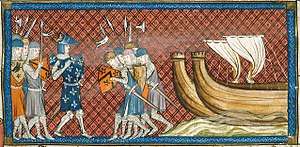
As Nur al-Din's territories became fragmented after his death, Saladin legitimised his ascent by positioning himself as a defender of Sunni Islam subservient to both the Caliph of Baghdad and Nur al-Din's son and successor, As-Salih Ismail al-Malik.[72] In the early years of his ascendency, he seized Damascus and much of Syria, but not Aleppo.[73] After building a defensive force to resist a planned attack by the Kingdom of Jerusalem that never materialised, his first contest with the Latin Christians was not a success. His overconfidence and tactical errors led to defeat at the Battle of Montgisard.[74] Despite this setback, Saladin established a domain stretching from the Nile to the Euphrates through a decade of politics, coercion, and low-level military action.[75] After a life-threatening illness early in 1186, he determined to make good on his propaganda as the champion of Islam, embarking on heightened campaigning against the Latin Christians.[76] King Guy responded by raising the largest army that Jerusalem had ever put in the field. However, Saladin lured the force into inhospitable terrain without water supplies, surrounded the Latins with a superior force, and routed them at the Battle of Hattin. Saladin offered the Christians the option of remaining in peace under Islamic rule or taking advantage of 40 days' grace to leave. As a result, much of Palestine quickly fell to Saladin including, after a short five-day siege, Jerusalem.[77] According to Benedict of Peterborough, Pope Urban III died of deep sadness on 19 October 1187 on hearing of the defeat.[78] His successor as Pope, Gregory VIII issued a papal bull titled Audita tremendi that proposed a further Crusade later named the Third Crusade to recapture Jerusalem. On 28 August 1189 King Guy of Jerusalem besieged the strategic city of Acre, only to be in turn besieged by Saladin.[79][80] Both armies could be supplied by sea so a long stalemate commenced. Such were the deprivations of the Crusaders that at times they are thought to have resorted to cannibalism.[81]
The journey to the Eastern Mediterranean was inevitably long and eventful. Travelling overland, Frederick I, Holy Roman Emperor, drowned in the Saleph River, and few of his men reached the Eastern Mediterranean.[82] Travelling by sea, Richard the Lionheart, King of England conquered Cyprus in 1191 in response to his sister and fiancée, who were travelling separately, being taken captive by the island's ruler, Isaac Komnenos.[83] Philip II of France was the first king to arrive at the siege of Acre; Richard arrived on 8 June 1191.[79] The arrival of the French and Angevin forces turned the tide in the conflict, and the Muslim garrison of Acre finally surrendered on 12 July. Philip considered his vow fulfilled and returned to France to deal with domestic matters, leaving most of his forces behind. But Richard travelled south along the Mediterranean coast, defeated the Muslims near Arsuf, and recaptured the port city of Jaffa. He twice advanced to within a day's march of Jerusalem before judging that he lacked the resources to successfully capture the city, or defend it in the unlikely event of a successful assault, while Saladin had a mustered army. This marked the end of Richard's crusading career and was a calamitous blow to Frankish morale.[84] A three-year truce was negotiated that allowed Catholics unfettered access to Jerusalem.[85] Politics in England and illness forced Richard's departure, never to return, and Saladin died in March 1193.[79] Emperor Henry VI initiated the German Crusade to fulfil the promises made by his father, Frederick, to undertake a Crusade to the Holy Land. Led by Conrad, Archbishop of Mainz, the army captured the cities of Sidon and Beirut. However, in 1197 Henry died and most of the Crusaders returned to Germany to protect their holdings and take part in the election of his successor as Emperor.[86]
13th century
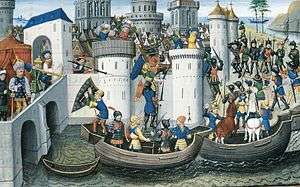
Pope Innocent III also began preaching what became the Fourth Crusade in 1200, primarily in France but also in England and Germany.[87] After gathering in Venice, the Crusade was used by Doge Enrico Dandolo and Philip of Swabia to further their secular ambitions. Dandolo aimed to expand Venice's power in the Eastern Mediterranean, and Philip intended to restore his exiled nephew, Alexios IV Angelos, along with Angelos's father, Isaac II Angelos, to the throne of Byzantium. This would require overthrowing the present ruler, Alexios III Angelos, the uncle of Alexios IV.[88] When an insufficient number of knights arrived in Venice, the Crusaders were unable to pay the Venetians for a fleet, so they agreed to divert to Constantinople and share what could be looted as payment. As collateral, the Crusaders seized the Christian city of Zara; Innocent was appalled, and promptly excommunicated them.[89] However, the French Crusaders eventually had their excommunications lifted. When the original purpose of the campaign was defeated by the assassination of Alexios IV Angelos, they conquered Constantinople, not once but twice. Following upon their initial success, the Crusaders captured Constantinople again and this time sacked it, pillaging churches and killing many citizens. The Fourth Crusade never came within 1,000 miles of its objective of Jerusalem.[90]
The 13th century saw popular outbursts of ecstatic piety in support of the Crusades such as that resulting in the Children's Crusade in 1212. Large groups of young adults and children spontaneously gathered, believing their innocence would enable success where their elders had failed. Few, if any at all, journeyed to the Eastern Mediterranean. Although little reliable evidence survives for these events, they provide an indication of how hearts and minds could be engaged for the cause.[91]
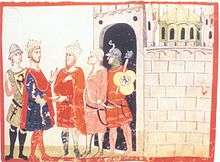
Following Innocent III's Fourth Council of the Lateran, crusading resumed in 1217 against Saladin's Ayyubid successors in Egypt and Syria for what is classified as the Fifth Crusade. Led by Andrew II of Hungary and Leopold VI, Duke of Austria, forces drawn mainly from Hungary, Germany, Flanders, and Frisia achieved little. Leopold and John of Brienne besieged and captured Damietta but an army advancing into Egypt was compelled to surrender.[92][93] Damietta was returned and an eight-year truce agreed.[94] Frederick II, Holy Roman Emperor, was excommunicated for breaking a treaty obligation with the Pope that required him to lead a crusade. However, since his marriage to Isabella II of Jerusalem gave him a claim to the kingdom of Jerusalem, he finally arrived at Acre in 1228. Frederick was culturally the Christian monarch most empathetic to the Muslim world, having grown up in Sicily, with a Muslim bodyguard and even a harem. His great diplomatic skills meant that the Sixth Crusade was largely negotiation supported by force.[95] A peace treaty was agreed upon, giving Latin Christians most of Jerusalem and a strip of territory that linked the city to Acre, while the Muslims controlled their sacred areas. In return, an alliance was made with Al-Kamil, Sultan of Egypt, against all of his enemies of whatever religion. The treaty and suspicions about Frederick's ambitions in the region made him unpopular, and he was forced to return to his domains when they were attacked by Pope Gregory IX.[96] While the Holy Roman Empire and the Papacy were in conflict, it often fell to secular leaders to campaign. What is sometimes known as the Barons' Crusade was led by Theobald I of Navarre and Richard of Cornwall; it combined forceful diplomacy and the playing of rival Ayyubid factions off against each other.[97] This brief renaissance for Frankish Jerusalem was illusory, being dependent on Ayyubid weakness and division following the death of Al-Kamil.[98]
In 1244 a band of Khwarezmian mercenaries travelling to Egypt to serve As-Salih Ismail, Emir of Damascus, seemingly of their own volition, captured Jerusalem en route and defeated a combined Christian and Syrian army at the Battle of La Forbie.[99] In response, Louis IX, king of France, organised a Crusade, called the Seventh Crusade, to attack Egypt, arriving in 1249.[100] It was not a success. Louis was defeated at Mansura and captured as he retreated to Damietta.[101] Another truce was agreed upon for a ten-year period, and Louis was ransomed. Louis remained in Syria until 1254 to consolidate the Crusader states.[102] From 1265 to 1271, the Mamluk sultan Baibars drove the Franks to a few small coastal outposts.[103]
Late 13th-century politics in the Eastern Mediterranean were complex, with a number of powerful interested parties. Baibars had three key objectives: to prevent an alliance between the Latins and the Mongols, to cause dissension between the Mongols particularly between the Golden Horde and the Persian Ilkhanate, and to maintain access to a supply of slave recruits from the Russian steppes. In this he developed diplomatic ties with Manfred, King of Sicily, supporting him against the Papacy and Louis IX's brother Charles of Anjou. The Crusader states were fragmented, and various powers were competing for influence. In the War of Saint Sabas, Venice drove the Genoese from Acre to Tyre where they continued to trade happily with Baibars' Egypt. Indeed, Baibars negotiated free passage for the Genoese with Michael VIII Palaiologos, Emperor of Nicaea, the newly restored ruler of Constantinople.[104]
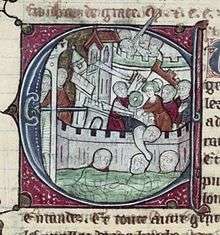
The French, led by Charles, similarly sought to expand their influence; Charles seized Sicily and Byzantine territory while marrying his daughters to the Latin claimants to Byzantium. To create his own claim to the throne of Jerusalem, Charles executed one rival and purchased the rights to the city from another. In 1270 Charles turned his brother King Louis IX's last Crusade, known as the Eighth Crusade, to his own advantage by persuading Louis to attack his rebel Arab vassals in Tunis. Louis' army was devastated by disease, and Louis himself died at Tunis on 25 August. Louis' fleet returned to France, leaving only Prince Edward, the future king of England, and a small retinue to continue what is known as the Ninth Crusade. Edward survived an assassination attempt organised by Baibars, negotiated a ten-year truce, and then returned to manage his affairs in England. This ended the last significant crusading effort in the Eastern Mediterranean.[105] The 1281 election of a French pope, Martin IV, brought the full power of the papacy into line behind Charles. He prepared to launch a crusade against Constantinople but, in what became known as the Sicilian Vespers, an uprising fomented by Michael VIII Palaiologos deprived him of the resources of Sicily, and Peter III of Aragon was proclaimed king of Sicily. In response, Martin excommunicated Peter and called for an Aragonese Crusade, which was unsuccessful. In 1285 Charles died, having spent his life trying to amass a Mediterranean empire; he and Louis had viewed themselves as God's instruments to uphold the papacy.[106]
The causes of the decline in Crusading and the failure of the Crusader States is multi-faceted. Historians have attempted to explain this in terms of Muslim reunification and Jihadi enthusiasm but Thomas Asbridge, amongst others, considers this too simplistic. Muslim unity was sporadic and the desire for Jihad ephemeral. The nature of Crusades was unsuited to the conquest and defence of the Holy Land. Crusaders were on a personal pilgrimage and usually returned when it was completed. Although the philosophy of Crusading changed over time, the Crusades continued to provide short-lived armies without centralised leadership led by independently minded potentates. What the Crusader states needed were large standing armies. Religious fervour enabled amazing feats of military endeavour but proved difficult to direct and control. Succession disputes and dynastic rivalries in Europe, failed harvests and heretical outbreaks, all contributed to reducing Latin Europe's concerns for Jerusalem. Ultimately, even though the fighting was also at the edge of the Islamic world, the huge distances made the mounting of Crusades and the maintenance of communications insurmountably difficult. It enabled Islam, under the charismatic leadership of Nur al-Din and Saladin as well as the ruthless Baibars to use the logistical advantages from proximity to victorious effect.[107] The mainland Crusader states of the outremer were finally extinguished with the fall of Tripoli in 1289 and Acre in 1291.[108] Many Latin Christians were evacuated to Cyprus by boat, were killed or enslaved.[109][110]
European campaigns
Northern Crusades
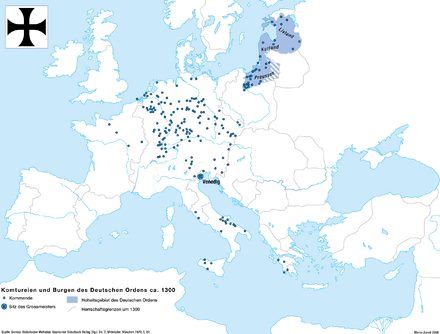
The success of the First Crusade inspired 12th-century popes such as Celestine III, Innocent III, Honorius III, and Gregory IX to call for military campaigns with the aim of Christianising the more remote regions of northern and north-eastern Europe. These campaigns are known as the Northern Crusades.[111] The Wendish Crusade of 1147 saw Saxons, Danes, and Poles attempt to forcibly convert the tribes of Mecklenburg and Lusatia, who were Polabian Slavs or "Wends". Celestine III called for a Crusade in 1193, but when Bishop Berthold of Hanover responded in 1198, he led a large army into defeat and to his death. In response, Innocent III issued a bull declaring a Crusade, and Hartwig of Uthlede, Bishop of Bremen, along with the Brothers of the Sword brought all of the north-east Baltic under Catholic control.[111] Konrad of Masovia gave Chelmno to the Teutonic Knights in 1226 as a base for a Crusade against the local Polish princes.[111][112] The Livonian Brothers of the Sword were defeated by the Lithuanians, so in 1237 Gregory IX merged the remainder of the order into the Teutonic Order as the Livonian Order.[113] By the middle of the century, the Teutonic Knights completed their conquest of the Prussians before conquering and converting the Lithuanians in the subsequent decades.[114] The order also came into conflict with the Eastern Orthodox Church of the Pskov and Novgorod Republics. In 1240 the Orthodox Novgorod army defeated the Catholic Swedes in the Battle of the Neva, and, two years later, they defeated the Livonian Order in the Battle on the Ice.[115]
Albigensian Crusade
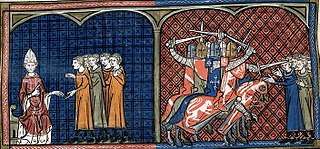
The Albigensian Crusade (1209–1229) was a campaign against heretics that Innocent III[116] launched to eradicate Catharism, which had gained a substantial following in southern France. The Cathars were brutally suppressed and the autonomous County of Toulouse formally submitted to the crown of France. The county's sole heiress Joan was engaged to Alphonse, Count of Poitiers, a younger brother of Louis IX of France. The marriage was childless so that after Joan's death the county fell under the direct control of Capetian France which was in part one of the motivations of the Crusaders.[117]
Bosnian Crusade
The Bosnian Crusade was a campaign against the independent Bosnian Church, which was accused of Catharism (Bogomilism). However, it was also possibly motivated by Hungarian territorial ambitions. In 1216 a mission was sent to convert Bosnia to Rome but failed. In 1225 Honorius III encouraged the Hungarians to crusade in Bosnia. This ended in failure after the Hungarians were defeated by the Mongols at the Battle of Mohi. From 1234 Gregory IX encouraged further crusading, but again the Bosniaks repelled the Hungarians.[118]
Reconquista

In the Iberian peninsula, Crusader privileges were given to those aiding the Templars, the Hospitallers, and the Iberian orders that merged with the orders of Calatrava and Santiago. The Christian kingdoms pushed the Muslim Moors and Almohads back in frequent Papal-endorsed Iberian Crusades from 1212 to 1265. The Emirate of Granada held out until 1492, at which point the Muslims and Jews were finally expelled from the peninsula.[119]
Late Middle Ages and Renaissance
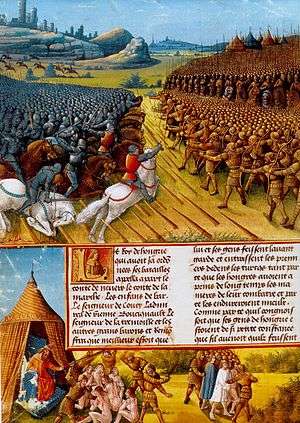
Minor Crusading efforts lingered into the 14th century, and several Crusades were launched during the 14th and 15th centuries to counter the expansion of the Ottoman conquest of the Balkans. In 1309 as many as 30,000 peasants gathered from England, north-eastern France, and Germany proceeded as far as Avignon but disbanded there.[120] Peter I of Cyprus captured and sacked Alexandria in 1365 in what became known as the Alexandrian Crusade; his motivation was as much commercial as religious.[121] Louis II led the 1390 Barbary Crusade against Muslim pirates in North Africa; after a ten-week siege, the Crusaders signed a ten-year truce.[122]
The Ottomans had conquered most of the Balkans and reduced Byzantine influence to the area immediately surrounding Constantinople after victory at the Battle of Kosovo in 1389. Nicopolis was seized from the Bulgarian Tsar Ivan Shishman in 1393 and a year later Pope Boniface IX proclaimed a new Crusade against the Turks, although the Western Schism had split the papacy.[123] This Crusade was led by Sigismund of Luxemburg, King of Hungary; many French nobles joined Sigismund's forces, including the Crusade's military leader, John the Fearless (son of the Duke of Burgundy). Sigismund advised the Crusaders to adopt a cautious, more defensive strategy, when they reached the Danube, instead they besieged the city of Nicopolis. The Ottomans defeated them in the Battle of Nicopolis on 25 September, capturing 3,000 prisoners.[124]
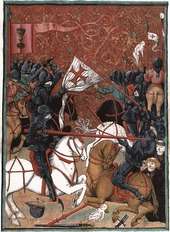
The Hussite Wars, also known as the Hussite Crusade, involved military action against the Bohemian Reformation in the Kingdom of Bohemia and the followers of early Czech church reformer Jan Hus, who was burned at the stake in 1415. Crusades were declared five times during that period: in 1420, 1421, 1422, 1427, and 1431. These expeditions forced the Hussite forces, who disagreed on many doctrinal points, to unite to drive out the invaders. The wars ended in 1436 with the ratification of the compromise Compacts of Basel by the Church and the Hussites.[125]
As the Ottomans pressed westward, Sultan Murad II destroyed the last Papal-funded Crusade at Varna on the Black Sea in 1444 and four years later crushed the last Hungarian expedition.[123] In 1453 they extinguished most of the remains of the Byzantine Empire with the capture of Constantinople. John Hunyadi and Giovanni da Capistrano organised a 1456 Crusade to oppose the Ottoman Empire and lift its Siege of Belgrade.[126] Æneas Sylvius and John of Capistrano preached the Crusade, the princes of the Holy Roman Empire in the Diets of Ratisbon and Frankfurt promised assistance, and a league was formed between Venice, Florence, and Milan, but nothing eventually came of it. In April 1487 Pope Innocent VIII called for a Crusade against the Waldensians of Savoy, the Piedmont, and the Dauphiné in southern France and northern Italy because they were unorthodox and heretical. The only efforts undertaken were in the Dauphiné, resulting in little change.[127] Venice was the only polity to continue to pose a significant threat to the Ottomans in the Mediterranean, but it pursued the "Crusade" mostly for its commercial interests, leading to the protracted Ottoman–Venetian Wars, which continued, with interruptions, until 1718. The end of the Crusading in terms of at least nominal efforts by Catholic Europe against Muslim incursion, came in the 16th century, when the Franco-Imperial wars assumed continental proportions. Francis I of France sought allies from all quarters, including from German Protestant princes and Muslims. Amongst these, he entered into one of the capitulations of the Ottoman Empire with Suleiman the Magnificent while making common cause with Hayreddin Barbarossa and a number of the Sultan's North African vassals.[128]
Crusader states

After the First Crusade's capture of Jerusalem and victory at Ascalon the majority of the Crusaders considered their personal pilgrimage complete and returned to Europe. Godfrey found himself left with only 300 knights and 2,000 infantry to defend the territory won in the Eastern Mediterranean. Of the crusader princes, only Tancred remained with the aim of establishing his own lordship.[51] At this point the Franks held Jerusalem and two great Syrian cities - Antioch and Edessa - but not the surrounding country. Jerusalem remained economically sterile despite the advantages of being the centre of administration of church and state and benefitting from streams of pilgrims.[129]
The "Law of Conquest" supported the seizure of land and property by impecunious Crusaders from the autochthonous population, enabling poor men to become rich and part of a noble class. Although some historians, like Jotischky, question the model once proposed, in which the primary motivation was understood in sociological and economic rather than spiritual terms.[130]
That class did not expel the native population, but adopted strict segregation and at no point attempted to integrate it by way of religious conversion. In this way the Crusaders created a colonial noble class that perpetuated itself through an incessant flow of religious pilgrims and settlers keen to take economic advantage. The territorial gains followed distinct ethnic and linguistic entities. The Principality of Antioch, founded in 1098 and ruled by Bohemond, became Norman in character and custom. The Kingdom of Jerusalem, founded in 1099, followed the traditions of northern France. The County of Tripoli, founded in 1104 (although the city of Tripoli itself remained in Muslim control until 1109) by Raymond de Saint-Gilles became Provençal. The County of Edessa, founded in 1098, differed in that although it was ruled by the French Bouillons and Courteneys its largely Armenian and Jacobite native nobility was preserved.[131][132] These states were the first examples of "Europe overseas". They are generally known by historians as Outremer, from the French outre-mer ("overseas" in English).[133][134]
Largely based in the ports of Acre and Tyre, Italian, Provençal and Spanish communes provided a significant characteristic of Crusader social stratification and political organisation. Separate from the Frankish nobles or burgesses, the communes were autonomous political entities closely linked to their countries of origin. This gave the inhabitants the ability to monopolise foreign trade and almost all banking and shipping in the Crusader states. Every opportunity to extend trade privileges was taken. One example saw the Venetian Doge receiving one third of Tyre, its territories and exemption from all taxes, after Venice participated in the successful 1124 siege of the city. However, despite all efforts, the two ports were unable to replace Alexandria and Constantinople as the primary centres of commerce in the region.[135] Instead, the communes competed with the Crown and each other to maintain economic advantage. Power derived from the support of the communards' native cities rather than their number, which never reached more than several hundred. Thus by the middle of the 13th century, the rulers of the communes were barely required to recognise the authority of the crusaders and divided Acre into a number of fortified miniature republics.[136]
The Fourth Crusade established a Latin Empire in the east and allowed participating crusaders to partition the Byzantine European territory. The Latin emperor controlled one-fourth of the Byzantine territory, Venice three-eighths (including three-eighths of the city of Constantinople), and the remainder was divided among the other leaders of the Crusade. This began the period of Greek history known as Frankokratia or Latinokratia ("Frankish [or Latin] rule"), when Catholic Western European nobles – primarily from France and Italy – established states on former Byzantine territory and ruled over the Orthodox Byzantine Greeks.[137][upper-alpha 1] In the long run, the sole beneficiary was Venice.[138]
Military orders
The Crusaders' mentality to imitate the customs from their Western European homelands meant that there were very few innovations developed from the culture of the crusader states. Three notable exceptions to this rule are the military orders, warfare and fortifications.[139] The Hospitallers (Order of Knights of the Hospital of Saint John of Jerusalem) were founded in Jerusalem before the First Crusade but added a martial element to its ongoing medical functions to become a much larger military order.[140] In this way the knighthood entered the previously monastic and ecclestical sphere.[141]
The military orders such as the Knights Hospitaller and the Knights Templar provided Latin Christendom's first professional armies in support of the Latin Kingdom of Jerusalem and the other Crusader states. The Poor Knights of Christ (Templars) and their Temple of Solomon were founded around 1119 by a small band of knights who dedicated themselves to protecting pilgrims en route to Jerusalem.[142] The Hospitallers and the Templars became supranational organisations as Papal support led to rich donations of land and revenue across Europe. This in turn led to a steady flow of new recruits and the wealth to maintain multiple fortifications across the Outremer. In time, this developed into autonomous power in the region.[143] After the fall of Acre the Hospitallers first relocated to Cyprus, then conquered and ruled Rhodes (1309–1522) and Malta (1530–1798), and continue in existence to the present day. Philip IV of France probably had financial and political reasons to oppose the Knights Templar, which led to him exerting pressure on Pope Clement V. The Pope responded in 1312, with a series of papal bulls including Vox in excelso and Ad providam that dissolved the order on the alleged and probably false grounds of sodomy, magic, and heresy.[144]
Legacy
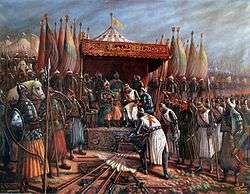
The Kingdom of Jerusalem was the first experiment in European colonialism creating a 'Europe Overseas' or Outremer.[88] The Arabs had come to dominate trade in the Mediterranean after their conquests.[145] Before the Crusades, Fatimids had trade relations with Italian city-states like Amalfi and Genoa. Amalfian merchants are attested to have lived in Cairo in 10th century by Cairo Geniza documents and were allowed to live in Jerusalem around 1060 by al-Mustansir.[146] In return for assisting the Crusaders, Genoa, Pisa and Venice were granted wide privileges in matter of land, trade and jurisdiction. Amalfi however didn't participate.[147] The raising, transportation, and supply of large armies led to flourishing trade between Europe and the outremer. The Italian city states of Genoa and Venice flourished, creating profitable trading colonies in the Eastern Mediterranean.[148] The colonies allowed them to engage in trade with eastern markets.[149] This trade was sustained through the middle Byzantine and Ottoman eras, and the communities were often assimilated and known as Levantines or Franco-Levantines.[upper-alpha 2][151]
The Crusades consolidated the papal leadership of the Latin Church, reinforcing the link between Western Christendom, feudalism, and militarism and increased the tolerance of the clergy to violence.[88] The growth of the system of indulgences became a catalyst for the Protestant Reformation in the early 16th century.[152] The Crusades also had a role in the creation and institutionalisation of the military and the Dominican orders as well as the Medieval Inquisition.[153]
The behaviour of the Crusaders appalled the Greeks and Muslims, creating a lasting barrier between the Latin world and both the Islamic and Orthodox religions. It was an obstacle to the reunification of the Christian church and created a perception of Westerners as defeated aggressors.[88]
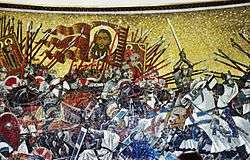
Many historians argue that the interaction between the western Christian and Islamic cultures was a significant, ultimately positive, factor in the development of European civilisation and the Renaissance.[154] The many interactions between Europeans and the Islamic world across the entire length of the Mediterranean Sea led to improved perceptions of Islamic culture, but also make it difficult for historians to identify the specific source of various instances of cultural cross-fertilisation.[155] The art and architecture of the Outremer show clear evidence of cultural fusion but it is difficult to track illumination of manuscripts and castle design back to their sources.[155] Textual sources are simpler, and translations made in Antioch are notable but considered secondary in importance to the works emanating from Muslim Spain and the hybrid culture of Sicily. In addition, Muslim libraries contained classical Greek and Roman texts that allowed Europe to rediscover pre-Christian philosophy, science and medicine.[156]
Jonathan Riley-Smith considers that much of the popular understanding of the Crusades derives from the novels of Walter Scott and the French histories by Joseph François Michaud. The Crusades provided an enormous amount of source material, stories of heroism, and interest that underpinned growth in medieval literature, romance, and philosophy.[88]
Historical parallelism and the tradition of drawing inspiration from the Middle Ages have become keystones of Islamic ideology. Secular Arab Nationalism concentrates on the idea of Western Imperialism. Gamal Abdel Nasser likened himself to Saladin and imperialism to the Crusades. In his History of the Crusades Sa'id Ashur emphasised the similarity between the modern and medieval situation facing Muslims and the need to study the Crusades in depth. Sayyid Qutb declared there was an international Crusader conspiracy. The ideas of Jihad and a long struggle have developed some currency.[157]
Historiography
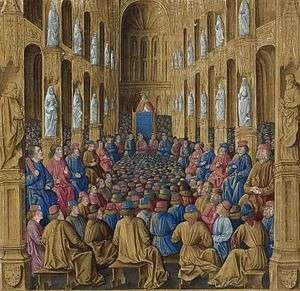
Five major sources of information exist on the Council of Clermont that led to the First Crusade: the anonymous Gesta Francorum (The Deeds of the Franks), dated about 1100–01; Fulcher of Chartres, who attended the council; Robert the Monk, who may have been present, and the absent Baldric, archbishop of Dol and Guibert de Nogent. These retrospective accounts differ greatly.[158] In his 1106–07 Historia Iherosolimitana, Robert the Monk wrote that Urban asked western Roman Catholic Christians to aid the Orthodox Byzantine Empire because "Deus vult" ("God wills it") and promised absolution to participants; according to other sources, the pope promised an indulgence. In these accounts, Urban emphasises reconquering the Holy Land more than aiding the emperor, and lists gruesome offences allegedly committed by Muslims. Urban wrote to those "waiting in Flanders" that the Turks, in addition to ravaging the "churches of God in the eastern regions", seized "the Holy City of Christ, embellished by his passion and resurrection—and blasphemy to say it—have sold her and her churches into abominable slavery". Although the pope did not explicitly call for the reconquest of Jerusalem, he called for military "liberation" of the Eastern Churches.[159]
During the 16th century Reformation and Counter-Reformation, Western historians saw the Crusades through the lens of their own religious beliefs. Protestants saw them as a manifestation of the evils of the papacy, and Catholics viewed them as forces for good.[160] 18th century Enlightenment historians tended to view the Middle Ages in general, and the Crusades in particular, as the efforts of barbarian cultures driven by fanaticism.[161] These scholars expressed moral outrage at the conduct of the Crusaders and criticised the Crusades' misdirection – that of the Fourth in particular, which attacked a Christian power (the Byzantine Empire) instead of Islam. The Fourth Crusade had resulted in the sacking of Constantinople, effectively ending any chance of reconciling the East–West Schism and leading to the fall of the Byzantine Empire to the Ottomans. In The History of the Decline and Fall of the Roman Empire, 18th-century English historian Edward Gibbon wrote that the Crusaders' efforts could have been more profitably directed towards improving their own countries.[6]
The 20th century produced three important histories of the Crusades: one by Steven Runciman, another by Rene Grousset, and a multi-author work edited by Kenneth Setton.[162] Historians in this period often echoed Enlightenment-era criticism: Runciman wrote during the 1950s, "High ideals were besmirched by cruelty and greed ... the Holy War was nothing more than a long act of intolerance in the name of God".[137] According to Norman Davies, the Crusades contradicted the Peace and Truce of God supported by Urban and reinforced the connection between Western Christendom, feudalism, and militarism. The formation of military religious orders scandalised the Orthodox Byzantines, and Crusaders pillaged countries they crossed on their journey east. Violating their oath to restore land to the Byzantines, they often kept the land for themselves.[163][164] The Fourth Crusade is widely considered controversial in its "betrayal" of Byzantium.[165] Similarly, Norman Housley viewed the persecution of Jews in the First Crusade – a pogrom in the Rhineland and the massacre of thousands of Jews in Central Europe – as part of the long history of anti-Semitism in Europe.[166]
With an increasing focus on gender studies in the early 21st century, studies have examined the topic of "Women in the Crusades". An essay collection on the topic was published in 2001 under the title Gendering the Crusades. In an essay on "Women Warriors", Keren Caspi-Reisfeld concludes that "the most significant role played by women in the West was in maintaining the status quo", in the sense of noble women acting as regents of feudal estates while their husbands were campaigning.[167] The presence of individual noble women in Crusades has been noted, such as Eleanor of Aquitaine (who joined her husband, Louis VII).[168] The presence of non-noble women in the Crusading armies, as in medieval warfare in general, was mostly in the role of logistic support (such as "washerwomen"),[167] while the occasional presence of women soldiers was recorded by Muslim historians.[169]
The Muslim world exhibited little interest in European culture until the 16th century and in the Crusades until the mid-19th century. There was no history of the Crusades translated into Arabic until 1865 and no published work by a Muslim until 1899.[170] In the late 19th century, Arabic-speaking Syrian Christians began translating French histories into Arabic, leading to the replacement of the term "wars of the Ifranj" – Franks – with al-hurub al Salabiyya – wars of the Cross. Namik Kamel published the first modern Saladin biography in 1872. The Jerusalem visit in 1898 of Kaiser Wilhelm prompted further interest, with Sayyid Ali al-Harri producing the first Arabic history of the Crusades. Muslim thinkers, politicians and historians have drawn parallels between the Crusades and modern political developments such as the French Mandate for Syria and the Lebanon, Mandatory Palestine, and the United Nations mandated foundation of the state of Israel.[171]
See also
- Arab–Byzantine wars (634–1050s)
- Art of the Crusades
- Byzantine–Ottoman Wars (1265–1479)
- Crusade cycle – Old French cycle of epic poems concerning the First Crusade
- The Crusades, An Arab Perspective
- History of the Jews and the Crusades
- Jihad
- List of principal Crusaders
- List of Crusader castles
- Ottoman Wars in Europe (1453–1922)
- Miles Christianus ("Christian soldier")
- Religious war
Notes
- ↑ The Partitio terrarum imperii Romaniae is a valuable record of early-13th-century Byzantine administrative divisions (episkepsis) and family estates.
- ↑ Frankolevantini; French Levantins, Italian Levantini, Greek Φραγκολεβαντίνοι, and Turkish Levantenler or Tatlısu Frenk leri. The term "Levantine" was used pejoratively for inhabitants of mixed Arab and European descent and for Europeans who adopted local dress and customs.[150]
References
- ↑ Asbridge 2012, p. 40
- ↑ Tyerman 2006, p. 259
- ↑ Ghil 1995, pp. 99–109
- ↑ "Crusade". Oxford English Dictionary (3rd ed.). Oxford University Press. September 2005. (Subscription or UK public library membership required.)
- ↑ Tyerman 2006, p. 480
- 1 2 Davies 1997, p. 358
- 1 2 Constable 2001, pp. 12–15
- ↑ Constable 2001, p. 12
- ↑ Riley-Smith 2009, p. 27
- ↑ Lock 2006, pp. 255–56
- ↑ Lock 2006, pp. 172–80
- ↑ Lock 2006, p. 167
- ↑ Davies 1997, pp. 362–64
- ↑ Tolan 2002, p. xv
- ↑ Retso 2003, pp. 505–06
- ↑ Retso 2003, p. 96
- ↑ "Frank". Oxford English Dictionary (3rd ed.). Oxford University Press. September 2005. (Subscription or UK public library membership required.)
- ↑ "Latin". Oxford English Dictionary (3rd ed.). Oxford University Press. September 2005. (Subscription or UK public library membership required.)
- ↑ Determann 2008, p. 13
- ↑ Wickham 2009, p. 280
- ↑ Lock 2006, p. 4
- ↑ Hindley 2004, p. 14
- ↑ Findley 2005, p. 73
- ↑ Asbridge 2012, p. 27
- ↑ Asbridge 2012, p. 28
- ↑ Bull 1999, pp. 18–19
- ↑ Mayer 1988, pp. 17–18
- ↑ Mayer 1988, pp. 2–3
- ↑ Rubenstein 2011, p. 18
- ↑ Cantor 1958, pp. 8–9
- ↑ Riley-Smith 2005, pp. 8–10
- ↑ Asbridge 2012, p. 34
- ↑ Pierson 2009, p. 103
- ↑ Hindley 2004, pp. 20–21
- ↑ Slack 2013, pp. 228–30
- ↑ Cohn 1970, pp. 61, 64
- ↑ Slack 2013, pp. 108–09
- ↑ Chazan 1996, p. 60
- ↑ Hindley 2004, p. 23
- ↑ Asbridge 2012, pp. 43–47
- ↑ Hindley 2004, pp. 30–31
- ↑ Asbridge 2012, pp. 52–56
- ↑ Asbridge 2012, pp. 57–59
- ↑ Asbridge 2012, pp. 21–22
- ↑ Asbridge 2012, pp. 59–61
- ↑ Asbridge 2012, pp. 72–73
- ↑ Asbridge 2012, pp. 72–82
- ↑ Asbridge 2012, pp. 146–53
- ↑ Asbridge 2012, pp. 96–103
- ↑ Asbridge 2012, pp. 104–06
- 1 2 Asbridge 2012, p. 106
- ↑ Riley-Smith 2005, pp. 23–24
- ↑ Tyerman 2006, pp. 192–94
- ↑ Asbridge 2012, pp. 111–13
- ↑ Asbridge 2012, p. 114
- ↑ Lock 2006, pp. 144–45
- ↑ Lock 2006, pp. 146–47
- ↑ Riley-Smith 2005, pp. 104–05
- ↑ Lock 2006, p. 144
- ↑ Hindley 2004, pp. 71–74
- ↑ Hindley 2004, pp. 77–85
- ↑ Tyerman 2006, pp. 281–88
- ↑ Hindley 2004, p. 77
- ↑ Hindley 2004, pp. 75–77
- ↑ Villegas-Aristizabal 2009, pp. 63–129
- ↑ Lock 2006, p. 148
- ↑ Lock 2006, p. 213
- ↑ Lock 2006, pp. 55–56
- ↑ Asbridge 2012, pp. 266–68
- ↑ Asbridge 2012, pp. 272–75
- ↑ Asbridge 2012, pp. 282–86
- ↑ Asbridge 2012, pp. 287–88
- ↑ Asbridge 2012, p. 292
- ↑ Asbridge 2012, pp. 307–08
- ↑ Asbridge 2012, p. 322
- ↑ Asbridge 2012, pp. 333–36
- ↑ Asbridge 2012, pp. 343–57
- ↑ Asbridge 2012, p. 367
- 1 2 3 Asbridge 2012, p. 686
- ↑ Asbridge 2012, pp. 398–405
- ↑ Asbridge 2012, p. 424
- ↑ Tyerman 2007, pp. 35–36
- ↑ Asbridge 2012, pp. 429–30
- ↑ Asbridge 2012, p. 509
- ↑ Asbridge 2012, pp. 512–13
- ↑ Lock 2006, p. 155
- ↑ Tyerman 2006, pp. 502–08
- 1 2 3 4 5 Davies 1997, pp. 359–60
- ↑ Lock 2006, pp. 158–59
- ↑ Asbridge 2012, p. 530
- ↑ Asbridge 2012, pp. 533–35
- ↑ Lock 2006, pp. 168–69
- ↑ Riley-Smith 2005, pp. 179–80
- ↑ Hindley 2004, pp. 561–62
- ↑ Asbridge 2012, pp. 566–71
- ↑ Asbridge 2012, p. 569
- ↑ Asbridge 2012, p. 573
- ↑ Asbridge 2012, p. 574
- ↑ Asbridge 2012, pp. 574–76
- ↑ Tyerman 2006, pp. 770–75
- ↑ Hindley 2004, pp. 194–95
- ↑ Lock 2006, p. 178
- ↑ Tyerman 2006, pp. 816–17
- ↑ Asbridge 2012, pp. 628–30
- ↑ Asbridge 2012, pp. 643–44
- ↑ Runciman 1958, p. 88
- ↑ Asbridge 2012, pp. 660–64
- ↑ Lock 2006, p. 122
- ↑ Asbridge 2012, p. 656
- ↑ Tyerman 2006, pp. 820–22
- 1 2 3 Davies 1997, p. 362
- ↑ Lock 2006, p. 96
- ↑ Lock 2006, p. 103
- ↑ Lock 2006, pp. 221–22
- ↑ Lock 2006, pp. 104, 221
- ↑ Riley-Smith 1999, p. 4
- ↑ Lock 2006, pp. 163–65
- ↑ Lambert 1977, p. 143
- ↑ Lock 2006, p. 211
- ↑ Lock 2006, pp. 187–88
- ↑ Lock 2006, pp. 195–96
- ↑ Lock 2006, p. 199
- 1 2 Davies 1997, p. 448
- ↑ Lock 2006, p. 200
- ↑ Lock 2006, pp. 201–02
- ↑ Lock 2006, pp. 202–03
- ↑ Lock 2006, p. 204
- ↑ Davies 1997, pp. 544–45
- ↑ Prawer 2001, p. 87
- ↑ Jotischky 2017, p. 39
- ↑ Prawer 2001, pp. 60–63
- ↑ Asbridge 2012, pp. 147–50
- ↑ "Outremer". Oxford English Dictionary (3rd ed.). Oxford University Press. September 2005. (Subscription or UK public library membership required.)
- ↑ Riley-Smith 2005, pp. 50–51
- ↑ Prawer 2001, pp. 85–87
- ↑ Prawer 2001, pp. 87–93
- 1 2 Runciman 1951, p. 480
- ↑ Davies 1997, p. 360
- ↑ Prawer 2001, p. 252
- ↑ Asbridge 2012, p. 169
- ↑ Prawer 2001, p. 253
- ↑ Asbridge 2012, p. 168
- ↑ Asbridge 2012, pp. 169–70
- ↑ Davies 1997, p. 359
- ↑ Couper 2015, p. 37
- ↑ Balard 2003, pp. 233, 234
- ↑ Balard 2003, p. 235
- ↑ Housley 2006, pp. 152–54
- ↑ Brundage 2004, p. 273
- ↑ "Levantine". Oxford English Dictionary (3rd ed.). Oxford University Press. September 2005. (Subscription or UK public library membership required.)
- ↑ Krey 2012, pp. 280–81
- ↑ Housley 2006, pp. 147–49
- ↑ Strayer 1992, p. 143
- ↑ Nicholson 2004, p. 96
- 1 2 Asbridge 2012, pp. 667–68
- ↑ Nicholson 2004, pp. 93–94
- ↑ Asbridge 2012, pp. 675–80
- ↑ Strack 2012, pp. 30–45
- ↑ Riley-Smith & Riley-Smith 1981, p. 38
- ↑ Lock 2006, p. 257
- ↑ Lock 2006, p. 259
- ↑ Lock 2006, p. 269
- ↑ Kolbaba 2000, p. 49
- ↑ Vasilev 1952, p. 408
- ↑ Nicolle 2011, p. 5
- ↑ Housley 2006, pp. 161–63
- 1 2 Caspi-Reisfeld 2002, p. 98
- ↑ Owen 1993, p. 22
- ↑ Nicholson 1997, p. 337
- ↑ Nicholson 2004, p. 95
- ↑ Asbridge 2012, pp. 674–75
Bibliography
- Asbridge, Thomas (2012). The Crusades: The War for the Holy Land. Simon & Schuster. ISBN 978-1-84983-688-3.
- Balard, Michel (2003). Bull, Marcus Graham; Edbury, Peter; Phillips, Jonathan, eds. The Experience of Crusading, Volume 2 — Defining the Crusader Kingdom. Cambridge University Press. ISBN 978-0-5217-8151-0.
- Brundage, James (2004). Medieval Italy: An Encyclopedia. Routledge. ISBN 978-1-1359-4880-1.
- Bull, Marcus (1999). "Origins". In Riley-Smith, Jonathan. The Oxford History of the Crusades. Oxford University Press. ISBN 978-0-19-280312-2.
- Cantor, Norman F (1958). Church. Kingship, and Lay Investiture in England: 1089–1135. Princeton University Press. ISBN 978-1-4008-7699-0.
- Caspi-Reisfeld, Keren (2002). "Women Warriors during the Crusades 1095–1254". In Edington, Susan B.; Lambert, Sarah. Gendering the Crusades. Columbia University Press. ISBN 978-0-231-12598-7.
- Chazan, Robert (1996). European Jewry and the First Crusade. U. of California Press. ISBN 978-0-520-91776-7. Retrieved 2016-10-04.
- Cohn, Norman (1970). The Pursuit of the Millennium. Oxford University Press. ISBN 978-0-19-500456-4.
- Constable, Giles (2001). "The Historiography of the Crusades". In Laiou, Angeliki E.; Mottahedeh, Roy P. The Crusades from the Perspective of Byzantium and the Muslim World. Dumbarton Oaks. ISBN 978-0-88402-277-0. Retrieved 2016-10-04.
- Couper, Alastair (2015). The Geography of Sea Transport. Routledge. ISBN 978-1317351504.
- Davies, Norman (1997). Europe – A History. Pimlico. ISBN 978-0-7126-6633-6.
- Determann, J. (2008). "The Crusades in Arabic Schoolbooks". Islam and Christian-Muslim Relations. Routledge. ISSN 0959-6410.
- Findley, Carter Vaughan (2005). The Turks in World History. Oxford University Press. ISBN 978-0-19-516770-2.
- Ghil, Eliza Miruna (1995). "Crozada: Avatars of a Religious Term in Thirteenth Century Occitan Poetry". TENSO: Bulletin of the Société Guilhem IX. 10 (2 (Spring 1995)): 99–109. doi:10.101353/ten.1995.0009 (inactive 2018-09-07).
- Hindley, Geoffrey (2004). The Crusades: Islam and Christianity in the Struggle for World Supremacy. Carrol & Graf. ISBN 978-0-7867-1344-8.
- Housley, Norman (2006). Contesting the Crusades. Blackwell Publishing. ISBN 978-1-4051-1189-8.
- Jotischky, Andrew (2017). Crusading and the Crusader States. Taylor & Francis. ISBN 978-1-3519-8392-1.
- Kolbaba, T. M. (2000). The Byzantine Lists: Errors of the Latins. University of Illinois. ISBN 978-0-252-02558-7.
- Krey, August C. (2012). The First Crusade: The Accounts of Eye-Witnesses and Participants. Arx Publishing. ISBN 978-1-935228-08-0.
- Lambert, Malcolm D. (1977). Medieval Heresy: Popular Movements from Bogomil to Hus. Holmes & Meier Publishers. ISBN 978-0-8419-0298-5.
- Lock, Peter (2006). Routledge Companion to the Crusades. Routledge. ISBN 978-0-415-39312-6.
- Mayer, Hans Eberhard (1988). The Crusades (Second ed.). Oxford University Press. ISBN 978-0-19-873097-2.
- Nicholson, Helen (1997). "Women on the Third Crusade". Journal of Medieval History. 23 (4): 335. doi:10.1016/S0304-4181(97)00013-4.
- Nicholson, Helen (2004). The Crusades. Greenwood Publishing Group. ISBN 978-0-313-32685-1.
- Nicolle, David (2011). The Fourth Crusade 1202–04: The Betrayal of Byzantium. Osprey Publishing. ISBN 978-1-84908-821-3.
- Owen, Roy Douglas Davis (1993). Eleanor of Aquitaine: Queen and Legend. Blackwell Publishing. ISBN 978-90-474-3259-3.
- Pierson, Paul Everett (2009). The Dynamics of Christian Mission: History Through a Missiological Perspective. WCIU Press. ISBN 978-0-86585-006-4. Retrieved 2016-10-04.
- Prawer, Joshua (2001). The CRusaders' Kingdom. Phoenix Press. ISBN 978-1-84212-224-2.
- Retso, Jan (2003). The Arabs in Antiquity: Their History from the Assyrians to the Umayyads. Routledge. ISBN 978-0-7007-1679-1.
- Riley-Smith, Jonathan (1999). Riley-Smith, Jonathan, ed. The Crusading Movement and Historians. The Oxford History of the Crusades. Oxford University Press. ISBN 978-0-19-280312-2.
- Riley-Smith, Jonathan (2005). The Crusades: A Short History (Second ed.). Yale University Press. ISBN 978-0-300-10128-7.
- Riley-Smith, Jonathan (2009). What Were the Crusades?. Palgrave Macmillan. ISBN 978-0-230-22069-0.
- The Crusades: Idea and Reality, 1095–1274. Documents of Medieval History. 4. E. Arnold. 1981. ISBN 978-0-7131-6348-3.
- Riley-Smith, Louise; Riley-Smith, Jonathan (1981). The Crusades: Idea and Reality, 1095–1274. Documents of Medieval History. 4. E. Arnold. ISBN 978-0-7131-6348-3.
- Rubenstein, Jay (2011). Armies of Heaven: The First Crusade and the Quest for Apocalypse. Basic Books. ISBN 978-0-465-01929-8.
- Runciman, Steven (1951). A History of the Crusades: The Kingdom of Acre and the Later Crusades (reprinted 1987 ed.). Cambridge University Press. ISBN 978-0-521-06163-6.
- Runciman, Steven (1958). The Sicilian Vespers. A History of the Mediterranean World in the Later Thirteenth Century (reprinted 1987 ed.). Cambridge University Press. ISBN 978-0-521-43774-5.
- Slack, Corliss K (2013). Historical Dictionary of the Crusades. Scarecrow Press. ISBN 978-0-8108-7831-0. Retrieved 2016-10-04.
- Strack, Georg (2012). "The Sermon of Urban II in Clermont and the Tradition of Papal Oratory" (PDF). Medieval Sermon Studies. 56: 30. doi:10.1179/1366069112Z.0000000002.
- Strayer, Joseph Reese (1992). The Albigensian Crusades. University of Michigan Press. ISBN 978-0-472-06476-2.
- Tolan, John Victor (2002). Saracens: Islam in the Medieval European Imagination. Columbia University Press. ISBN 978-0-231-12333-4.
- Tyerman, Christopher (2006). God's War: A New History of the Crusades. Belknap Press. ISBN 978-0-674-02387-1.
- Tyerman, Christopher (2007). The Crusades. Sterling Publishing Company, Inc. ISBN 978-1-4027-6891-0. Retrieved 2016-10-04.
- Vasilev, Aleksandr Aleksandrovich (1952). History of the Byzantine Empire: 324–1453. University of Wisconsin Press.
- Villegas-Aristizabal, L (2009). "Anglo-Norman involvement in the conquest of Tortosa and Settlement of Tortosa, 1148–1180". Crusades (8).
- Wickham, Chris (2009). The Inheritance of Rome: Illuminating the Dark Ages 400–1000. Penguin Books. ISBN 978-0-14-311742-1.
Further reading
- Asbridge, Thomas (2005). The First Crusade: A New History: The Roots of Conflict between Christianity and Islam. ISBN 978-0-19-518905-6.
- Daniel, Norman (1979). The Arabs and Mediaeval Europe. Longman Group Limited. ISBN 978-0-582-78088-0.
- Hodgson, Natasha (2007). Women, Crusading and the Holy Land in Historical Narrative. Boydell.
- Kahf, Mohja (1999). Western Representations of the Muslim Women: From Termagant to Odalisque. U of Texas Press. ISBN 978-0-292-74337-3.
- Madden, Thomas F. (2013). The Concise History of the Crusades. Rowman and Littlefield. ISBN 978-1-442-21575-7.
- Maier, Christoph T. (March 2004). "The roles of women in the Crusade movement: a survey". Journal of Medieval History. 30 (1): 61–82. doi:10.1016/j.jmedhist.2003.12.003.
- Paterson, Linda. 'Singing the Crusades. French and Occitan Responses the Crusading Movements, 1137–1336'. Cambridge: D.S.Brewer, 2018.
- Phillips, Jonathan. Holy Warriors: A Modern History of the Crusades (2010)
- Riley-Smith, Jonathan (ed.) The Oxford Illustrated History of the Crusades Paperback, Oxford University Press (2001).
- Riley-Smith, Jonathan. The Crusades: A history (Bloomsbury Publishing, 2014)
- Runciman, Steven. A History of the Crusades (3 vols. 1951–1954)
- Setton, Kenneth ed., A History of the Crusades, University of Wisconsin Press (6 vols., 1969–1989; online edition (wisc.edu))
- Includes: The first hundred years (2nd ed. 1969); The later Crusades, 1189–1311 (1969); The fourteenth and fifteenth centuries (1975); The art and architecture of the Crusader states (1977); The impact of the Crusades on the Near East (1985); The impact of the Crusades on Europe (1989).
- Tolan, John; Veinstein, Gilles; Henry, Laurens (2013). Europe and the Islamic World: A History. Princeton University Press. ISBN 978-0-691-14705-5.
- Villegas-Aristizábal, Lucas, "Pope Gregory VII and Count Eblous II of Roucy’s Proto-Crusade in Iberia c. 1073", Medieval History Journal 21.1 (2018), 1-24. http://journals.sagepub.com/doi/abs/10.1177/0971945817750508
Historiography
- Constable, Giles. "The Historiography of the Crusades" in Angeliki E. Laiou, ed. The Crusades from the Perspective of Byzantium and the Muslim World (2001) Extract online.
- Phillips, Jonathan. "A new history of the Crusades" The Telegraph 17 Sep 2006
- Powell, James M. "The Crusades in Recent Research," The Catholic Historical Review (2009) 95#2 pp. 313–19 in Project MUSE
- Rubenstein, Jay. "In Search of a New Crusade: A Review Essay," Historically Speaking (2011) 12#2 pp. 25–27 in Project MUSE
- von Güttner-Sporzyński, Darius. "Recent Issues in Polish Historiography of the Crusades" in Judi Upton-Ward, The Military Orders: Volume 4, On Land and by Sea (2008) available on Researchgate, available on Academia.edu
Primary sources
- Barber, Malcolm, Bate, Keith (2010). Letters from the East: Crusaders, Pilgrims and Settlers in the 12th–13th Centuries (Crusade Texts in Translation Volume 18, Ashgate Publishing Ltd)
- Bird, Jessalynn, et al. eds. Crusade and Christendom: Annotated Documents in Translation from Innocent III to the Fall of Acre, 1187–1291 (2013) excerpts
- Housley, Norman, ed. Documents on the Later Crusades, 1274–1580 (1996)
- Savignac, David. "The Medieval Russian Account of the Fourth Crusade - A New Annotated Translation".
- Shaw, M. R. B. ed.Chronicles of the Crusades (1963)
- Villehardouin, Geoffrey, and Jean de Joinville. Chronicles of the Crusades ed. by Sir Frank Marzials (2007)
